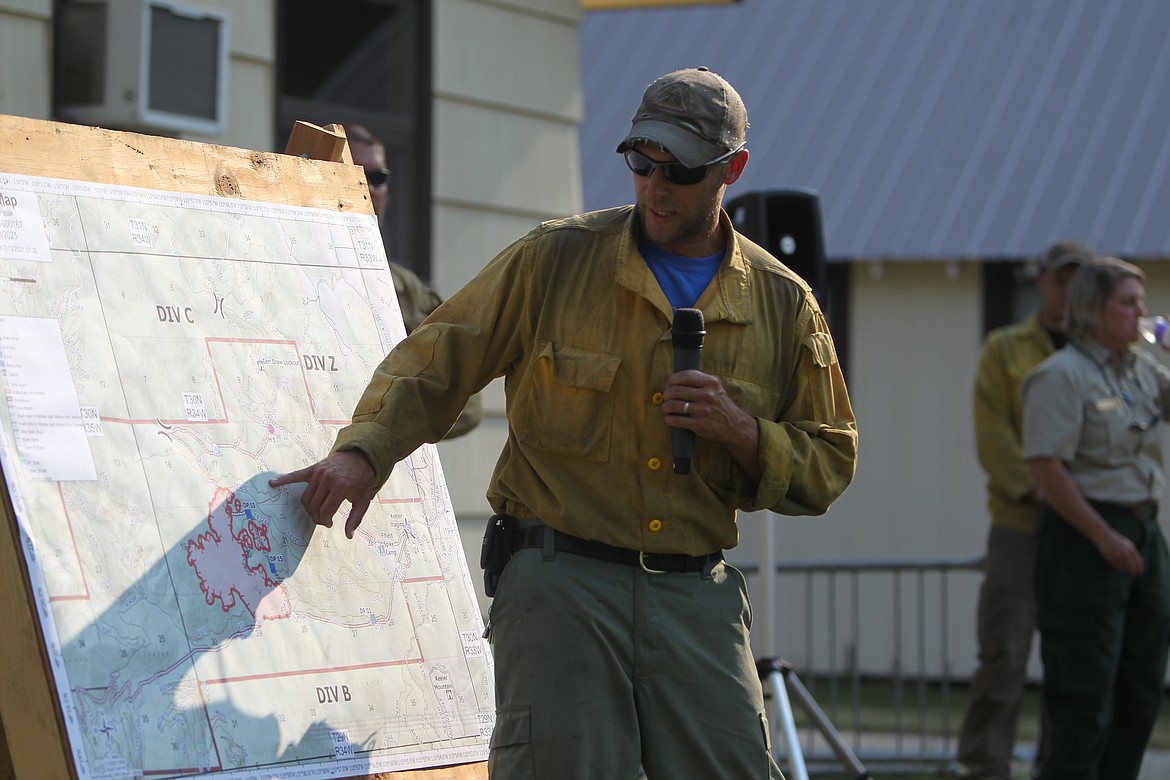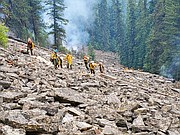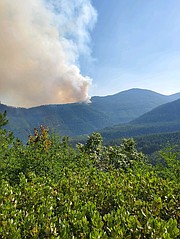Burnt Peak Fire surpasses 1,000 acres
As the Burnt Peak Fire continued to grow this week, breaking records for the Kootenai National Forest, U.S. Forest Service and local officials briefed the public on containment efforts and attempted to quell rumors about evacuation notices.
Dan Rose, forest fire manager for the Kootenai National Forest, told residents gathered at a July 13 meeting in Troy that the fire — which had grown to 910 acres as of that morning — was the largest that forest service officials had seen this early in the season in the Kootenai.
Recent extreme hot and dry weather only made conditions worse.
“We have really solid weather records that go back to at least 1954 and we have never been this dry this early,” said Rose.
Gov. Greg Gianforte issued a statewide fire emergency on Wednesday due to the abnormally dry conditions. The declaration allows Gianforte to mobilize the Montana National Guard to assist in firefighting efforts and activate the Emergency Management Assistance Compact, a nationwide agreement that permits states to share resources during emergencies.
Nearly 1,400 wildland fires had burned around 141,000 acres across the state as of Wednesday, according to the governor’s office.
By Thursday morning the fire, which is burning roughly eight miles southwest of Troy, had grown to 1,361 acres with 110 personnel working the blaze. The fire was at 10 percent contained.
Officials said lightning sparked the fire.
A nationwide shortage of firefighting resources has complicated containment efforts. Rose said that the country was at a fire preparedness level of four out of five, meaning that most resources were already tied up battling other blazes. At the regional and local levels, officials were at a five out of five preparedness level.
Despite the shortages, Rose said officials have continued sending equipment to the Kootenai due to the forest’s emphasis on initial attack.
“Nobody else wants to see other large fires,” he said. “If we have an opportunity to get a resource to keep the fire small, they’re going to send it to us and we're going to put that thing to work.”
Rose said the Kootenai officials were fortunate to have four helicopters, including a rappel helicopter, at their disposal.
At the time of the meeting, Brent Teske, deputy director of the county Emergency Management Agency, said local officials had already ordered four pre-evacuation notices. Soon afterward, some residents began spreading rumors that officials were evacuating the Iron Creek and Lake Creek areas.
“That kind of information just instills panic in people and it makes it tough for the public to understand what is going on so please check credible sources,” said Teske.
While firefighters might warn residents about an impending evacuation, Sheriff Darren Short said law enforcement officials would be on scene if ever an evacuation order came down the pike.
Teske and Short urged residents to sign up for Code Red, the county’s emergency notification system. Unlike reverse 911 calls, which can only reach landlines, Code Red allows dispatchers to get in touch with residents through cell phones.
Officials said the fire would have to progress past certain trigger points before they would begin issuing evacuation orders. At the time of the meeting, officials were not concerned about the fire’s behavior.
The Burnt Peak Fire started around 9:30 a.m. on July 7 when a storm cell passed over the Keeler Rattle area. Cory Farmer, incident commander trainee, said crews reached the fire and launched helicopters within an hour.
Two hours later, the fire had grown to five acres and was burning about 2,000 acres above Keeler Rattle Road, the route Forest Service officials used to access the scene. The blaze began steadily moving down the steep terrain, downing snags and throwing up spot fires.
Crews worked on the fire until midnight on July 7 and Forest Service officials started bringing in heavy equipment. The following day, firefighters ordered in air tankers and helicopters as the blaze grew to 100 acres.
“It’s on the south aspect so there’s absolutely no shade relief from the sun,” said Farmer. “Just prime conditions for large active fire growth.”
The fire continued to grow steadily throughout the week. As of July 13, firefighters had 10 percent of the blaze contained. While the Forest Service will continue batting the fire, Rose said officials would likely have to wait on Mother Nature to put it out.
“Once it snows, it’ll be done,” he said.







